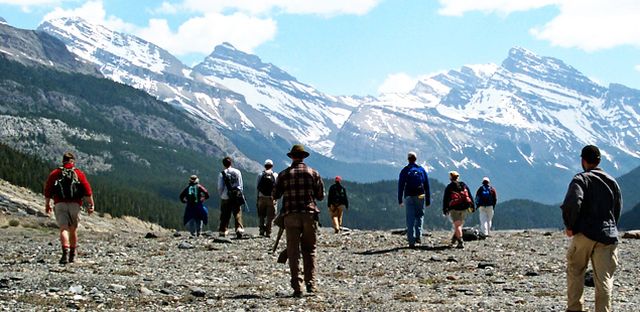
Geology Faculty Publications
40Ar/39Ar Thermochronologic Constraints on the Tectonothermal Evolution of the Northern East Humboldt Range Metamorphic Core Complex
Document Type
Article
Publication Date
11-1994
Publication Source
Tectonophysics
Abstract
The northern East Humboldt Range (NEHR) of northeastern Nevada exposes a suite of complexly deformed migmatitic, upper amphibolite-facies rocks in the footwall of the Ruby Mountains-East Humboldt Range (RM-EHR) detachment fault. New 40Ar/39Ar data on hornblende, muscovite, biotite, and potassium feldspar help constrain the kinematic and thermal evolution of this terrain during Tertiary extensional exhumation. Hornblende samples from relatively high structural levels yield discordant age spectra that suggest initial cooling during early Tertiary time (63–49 Ma). When coupled with petrological constraints indicating a strongly decompressional P-T-t path above 550°C, the hornblende data suggest that exhumation of the RM-EHR may have initiated in early Tertiary time, approximately coincident with the initial phases of unroofing in the Wood Hills immediately to the east and with the end of thrusting in the late Mesozoic to early Tertiary Sevier orogenic belt of eastern Nevada and western Utah. This temporal coincidence suggests that gravitational collapse of tectonically thickened crust in the internal zone of the Sevier belt could have driven the initial phases of unroofing.
Thermal history during the final stage of exhumation of the NEHR is constrained by discordant hornblende cooling ages of 36-29 Ma from deep structural levels and biotite, muscovite, and potassium feldspar cooling ages of 27-21 Ma from a range of structural levels. Comparison of muscovite, biotite, and potassium feldspar cooling ages with previously published fission-track cooling ages implies very rapid cooling rates at temperatures below the closure temperature for muscovite (270°–350°C), but time gaps of > 7 m.y. between hornblende and mica cooling ages suggest that cooling at higher temperatures was more gradual. In addition, comparison of mica cooling ages with previously published fission-track apatite cooling ages suggests pronounced thermal gradients between the NEHR and adjacent areas during latest Oligocene to earliest Miocene time. Such thermal gradients could be readily explained if the RM-EHR detachment fault dipped > 30° between the 300°C and 100°C isotherms. Finally, biotite cooling ages increase southward through the East Humboldt Range, compatible with northward extrapolation of a previously recognized pattern of WNW-younging biotite cooling ages from the Ruby Mountains. A simple model involving the propagation of footwall uplift in the direction of tectonic transport beneath an initially listric normal fault can explain the principle features of the Oligocène to Miocene thermochronologic data set for the RM-EHR.
Inclusive pages
425–450
ISBN/ISSN
0040-1951
Copyright
Copyright © 1994, Elsevier
Publisher
Elsevier
Volume
238
Issue
1-4
Peer Reviewed
yes
eCommons Citation
McGrew, Allen J. and Snee, Lawrence W., "40Ar/39Ar Thermochronologic Constraints on the Tectonothermal Evolution of the Northern East Humboldt Range Metamorphic Core Complex" (1994). Geology Faculty Publications. 31.
https://ecommons.udayton.edu/geo_fac_pub/31
COinS



Comments
Permission documentation is on file.